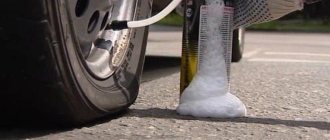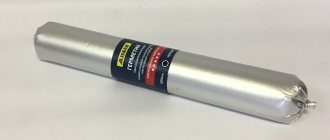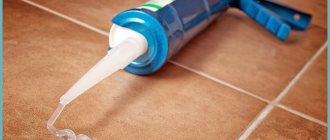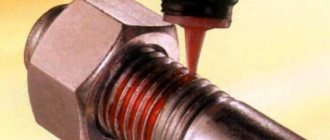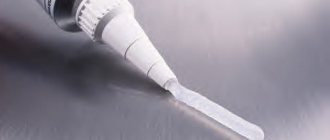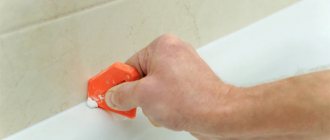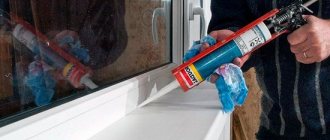What is automotive sealant?
The tightness of the mechanisms in the factory version of the design of any car is achieved using rubber or metal gaskets - wear-resistant layers that prevent leaks.
As it wears out, the gasket layer loses its properties and functionality, and the tightness between the adjacent parts of the machine units is broken. In such cases, experienced drivers replace worn gaskets with automotive sealants.
A “liquid gasket” is a viscous, paste-like substance that, when dried, hardens to form a durable sealing layer.
The use of sealants is important when servicing almost all structural elements of a car.
Types of sealants
A sealant is a composition of oligomers or polymers that has a paste-like or viscous state. The intended use of these substances is waterproofing and sealing.
Today there are a large number of different types of sealants on the market. They not only differ in composition, but are also designed for gluing different surfaces under completely different operating conditions.
- By composition.
- By method of application.
The composition is usually divided into:
- Silicone sealants. These are moisture-resistant joints that can withstand fairly high temperatures and are capable of forming an elastic seam at the joint. Silicone compounds are also not homogeneous; they can be universal, silicate, that is, maximum heat-resistant, withstand up to 1200 degrees, auto repair and sanitary.
- Acrylic. The main distinguishing feature is its fairly high adhesion to various types of plastics. The seam also turns out to be elastic, but at this point it will be clearly inferior to the silicone version. They are chemically neutral and not resistant to moisture. When joining wood flooring, different colors of these sealants are usually used.
- Polyurethane or polyurethane foam.
- Bitumen. Typically used in construction.
Purpose of auto sealant
Depending on its purpose, the product is used as a sealant for:
- car headlights . Allows you to restore the tightness of the optics if the headlight glasses are damaged or replaced. Used for quickly gluing car headlight glasses or assembling its elements on the road;
- self-gluing car windows . The best way to seal auto glass on the windshield of a car and other vehicles;
- car engine . The optimal way to ensure the safety of the structural elements of the power unit. Engine compounds help eliminate leaks and hermetically seal connections between parts. Used when replacing a pump, to seal the valve cover and transmission pan;
- car tires and wheels . Helps out in emergency situations, i.e. for punctures and damage to tubed and tubeless tires. Allows you to quickly carry out repair work in outdoor conditions;
- car air conditioner . Helps not only eliminate, but also prevent refrigerant leaks, therefore it is often used as a preventive measure;
- car seams . It is used in body repair - to seal the seams of the hood, trunk, underbody, doors.
- thread sealing . Compositions designed for threaded connections prevent leakage at hose and pipe fittings and replace traditional gaskets in pneumatic and hydraulic circuits. Ensures a tight fit of the threads even under high pressure.
The effectiveness of using adhesive-sealant for a car is determined by its type, properties and purpose.
The best sealants for cooling systems
Sealant compounds intended for cooling systems can be liquid or powder. They are designed to seal leaks without disassembling and sealing elements. Almost instantly prevents coolant leakage.
ABRO 12-AB
The average cost is 100 rubles.
The squeeze-out sealant, in addition to preventing leaks in the cooling system, can be used for the engine. It does not deteriorate from exposure to high temperatures and is resistant to liquids.
Application area: engine, car cooling system. Available in convenient tubes for easy application. Withstands temperatures up to +260 oC.
ABRO 12-AB
Advantages
- ease of use;
- hardens quickly.
Flaws
- A little uncomfortable tube.
“I bought it by accident, but it came in handy for stopping a leak while traveling. Enough time has passed and nothing is leaking. I keep it in the car just in case; it doesn’t take up much space and works well.”
Victor A., Voronezh
LIQUI MOLY KuhlerDichter 1997
Average cost 450 rub.
A brand of sealant designed to repair small radiator leaks. Removes pores in metal in places of soldering. Effectively fills cracks. Due to its chemical formula, it is not able to react with antifreeze under any conditions.
High penetration allows you to eliminate leaks that cannot be clearly localized.
The sealing layer does not change properties from exposure to any liquids. The sealant layer protects its integrity even under extreme heat.
LIQUI MOLY KuhlerDichter 1997
Advantages
- effectively levels surfaces;
- works at high temperatures.
Flaws
- No.
“Suitable for heating systems too. I have been using this brand for a long time, it always applies well, and never crumbles due to temperature changes. I recommend".
Oleg S., Orel
Done Deal DD6731
Average price 200 rub.
Composition with increased heat resistance. Maintains the integrity of the layer for many years due to elements in the composition that increase durability. The scope of application includes cooling and heating systems, repair of elements that cannot be disassembled, parts exposed to high temperatures during operation.
You will be interested in: TOP 10 best organizer for the trunk of a car: rating, how to choose, how to make it yourself, characteristics, reviews, pros and cons
The composition can replace any silicone factory materials.
The service life of the applied sealant is significantly increased due to the addition of copper compounds to the composition during production.
Done Deal DD6731
Advantages
- tolerates intense vibration well;
- withstands extremely high temperatures.
Flaws
- not always on sale.
“Purchased to work in a car with an oxygen sensor. No smell, easy to apply. I didn’t find any problems during the repair process.”
Sergey V., Moscow.
Types of sealants
There is a huge selection of automotive sealants. They differ from each other in composition, technical characteristics and operational properties. All products presented on the auto chemical market belong to the category of synthetic compounds. They are made from polymer resins. Based on the type of polymer, such products are divided into anaerobic (acrylic), silicone and polyurethane.
Anaerobic
They are based on dimethacrylate esters, which can maintain a liquid state only in the presence of contact with oxygen. When, after tightly joining the parts, access to air is closed, the sealant located between them quickly hardens.
The anaerobic composition includes polyfunctional acrylic compounds, stabilizers, dyes, and thickening components.
Advantages of anaerobic compounds:
- resistance to high temperatures and aggressive environments;
- elasticity;
- maintaining operational properties under strong vibration loads;
- corrosion resistance;
- wide range of viscosity, possibility of use in gaps from 0.07 mm to 0.5 mm;
- frost resistance.
These products are used only for metal products. The scope of application of anaerobic sealants is sealing, fixing and sealing threaded and flanged connections, cylindrical parts and welds.
Most often, this type of “liquid gaskets” is used by professional car service workers.
Silicone
Silicone sealants based on low molecular weight rubber are very popular among car enthusiasts, due not only to their convenience and ease of use, but also to their relatively low cost.
All types of silicone auto sealants are characterized by rapid hardening at room temperature, due to interaction with moisture contained in the air.
The main advantages of silicone “liquid gaskets”:
- elasticity;
- water resistance;
- high level of adhesion;
- resistance to aggressive environments and ultraviolet radiation;
- oil resistance; does not dissolve in any types of fuel and lubricants;
- preventing the formation of corrosion;
- heat resistance;
- no unpleasant odor;
- strength and wear resistance of the seam.
Areas of application of silicone compounds: sealing gaps up to 7 mm in size on any surfaces of engines, gearboxes, front and rear axles of a car, joints and mating of cylinder liners, as well as for gluing parts made of plastic and glass - headlights, sidelights, hatches, brake lights.
Polyurethane
Polyurethane sealants are produced on the basis of polymer compounds. Such compositions are a viscous substance that can harden upon contact with moisture from the air.
The main advantages that distinguish polyurethane adhesive sealant:
- elasticity level 1000%;
- high degree of adhesion to metal and glass;
- resistance to water, ultraviolet radiation, high and low temperatures;
- no shrinkage after hardening.
Polyurethane compounds are used as glass sealants for gluing car window glass, for repairing headlights, for sealing seams, and also for eliminating gaps in body parts.
A significant drawback of polyurethane glue is its poor resistance to constant exposure to temperatures above 120° C. To apply the product evenly, use a special gun for sealants.
How to choose joint sealant
Before you move on to choosing a sealant for the body, you need to decide on the answer to the question of what it is needed for. Even at the stage of body production in the factory, the manufacturer treats its surface with special compounds that are designed to protect it from minor mechanical damage and corrosion. This is especially true for various joints, recesses, welds and other transitional surfaces.
The use of body sealant in repair shops (or in garage conditions) is due to the same purposes. The only difference is the repair or replacement of any body part. The purpose of sealant for automobile body seams is to protect them from corrosion (both liquid and electrolytic), as well as minor mechanical damage.
Based on this, it is possible to formulate the criteria that the sealant chosen for purchase must meet. So, these include:
- Durability . The sealant should not lose its performance properties for as long as possible (ideally the entire service life of the machine).
- Elasticity . Many seams are curved rather than straight. Accordingly, in the frozen state, the sealant for car welds must be elastic. In addition, the car body is constantly subject to vibration while it is moving, therefore, under such conditions, the product must also perform its functions normally.
- High adhesion . These are properties of the sealant that allow it to adhere to the surface to which it is applied (and this is not always pure metal).
- Resistance to external factors . In particular, to the effects of moisture, ultraviolet radiation, technological automotive fluids (fuel, oil, brake fluid, washer fluid and others), overheating and hypothermia.
- Possibility of painting . All joint sealants are divided into those that can be painted (varnish applied to them) and those that cannot be painted.
The better the sealant for treating weld seams meets the listed requirements, the better the protection of both the seams themselves and the car body as a whole will be protected.
Sealant selection criteria
When choosing a sealant, you should pay attention to ensure that its technical characteristics correspond to the operating characteristics of the parts.
During operation, vehicle components may heat up or be subject to various types of loads. Therefore, important parameters for choosing a sealant are the properties of the active substances in the composition of the product:
- viscosity level;
- heat resistance;
- degree of resistance to high pressure and vibration loads;
- elasticity after hardening;
- durability of the resulting connection.
The presence of a dispenser and the need to use a sealant gun also plays a role when choosing a sealant.
If the sealing composition is characterized by poor resistance to high temperatures, it should not be used to process engine parts, since during operation such a compound will quickly collapse under the influence of heat.
In addition, car enthusiasts attach great importance to how long the product dries. For example, anaerobic compounds polymerize only in the absence of contact with oxygen. This means that the driver has time to calmly and without haste apply the product to the surface of the parts and connect them, without fear that the substance will harden ahead of time.
Silicone sealants harden within 10 minutes, but do not require special precision of application, so they can be used even by inexperienced drivers.
On the other hand, the use of silicone products is appropriate when filling deep gaps, while anaerobic compounds can fill unevenness no more than 0.5 cm deep.
You should not buy large volumes of the product - during storage, polymer substances lose their properties, which eliminates the possibility of reuse.
Detailed recommendations for the use of sealants, as well as information on how long the sealing composition takes to dry, can be found in the instructions supplied by the manufacturer.
How to properly apply sealant when repairing a car
There are no difficulties in using sealant, there are simply small nuances that are best known before starting sealing work, this will help to avoid unnecessary difficulties in the future.
- The surfaces that need to be glued must first be thoroughly cleaned and degreased with alcohol or a special degreaser. If the damaged part has already been treated with sealant, its remnants should be very carefully removed.
- Apply sealant to the surface in a continuous layer. It is very important to ensure that the liquid does not break. You need to apply the seam in a not very thick strip, about 1mm, because when squeezing two surfaces, it can be squeezed out too much, which is absolutely unnecessary for anyone. Another important point should be considered the fact that it is advisable to apply the sealant only to one of the surfaces to be bonded. This will make it possible to separate these surfaces again in the future without much difficulty.
- After applying the sealant, you need to let it dry a little, about 10 minutes, then the parts are connected, and the bolts are tightened a little, before squeezing out the adhesive. After another 10 minutes, tighten the bolts completely.
- The glued part can be used only after the time indicated on the packaging has passed, this can be 20 minutes or even several hours. Thus, anaerobic sealants have a much longer hardening time compared to conventional silicone, but this allows you to take your time when carrying out repair work.
Adhesive for glass and headlights
When choosing a sealant for car windows and headlights, you need to pay attention to the material from which they are made. To preserve aesthetics, it is recommended to choose transparent glass compositions.
Some compounds for gluing car headlight glasses are incompatible with polycarbonate and can lead to its destruction.
Sealant Abro WS 904
It is one of the best sealants for car windows and windshields. Abro WS 904 is produced in America in the form of double-sided self-adhesive tape made of vulcanized polyisobutylene.
Characterized by particular ease of use:
- To seal a windshield or window, it must be removed and the remnants of the old sealant removed;
- release the tape from the paper base;
- place the tape in the groove, distribute evenly and press lightly;
- trim off excess tape at the edges;
- Install the windshield and press along the entire perimeter.
The product dries almost instantly, without staining your hands or spreading.
Sealant manufacturers
On store shelves there are sealants of both domestic and foreign production. The former are most often distinguished by aluminum tubes with plastic caps. Products from foreign companies can be distinguished by weight; usually their sealant containers are available in two sizes: 40 and 90 grams. Among the best compositions are the following:
Loctite 574
Anaerobic flange sealant from Henkel costs about 1,200 rubles. This composition hardens at temperatures from +15 to +25 degrees, while a fairly strong and elastic layer is formed on metal surfaces. Typically used for small cracks and gaps.
Elring Dirko
The manufacturer produces high-quality compounds that can be used in difficult conditions, costing from 400 rubles. Reliable and durable products are used in the assembly of heads, blocks, covers and other mating engine parts. Many car enthusiasts compare the quality of this material with welding. Elring can withstand high temperatures and vibrations.
Dowcorning Q3 1566
This heat-resistant compound hardens at room temperature. The sealant is resistant to automotive oils and coolants. Often used when machining engine crankcases and flanges. Costs about 1,200 rubles.
There are other manufacturers that produce good and inexpensive sealants that you can use yourself without the help of specialists.
Thread liquid sealant
To seal threaded connections, products with a low level of viscosity are used. Reliable fixation of the threads of machine units will be ensured by the following means:
- Polyloc 275 is a flow-through compound for repairing parts. It is an anaerobic one-component product based on dimethacrylate ether. Designed for sealing galvanic surfaces, as well as permanent connections made of stainless steel or aluminum. It is applied to the thread using a dispenser and fixed during the assembly of parts. The average drying time of the sealant is 2 hours. Resistant to vibrations;
- DoneDeal blue is a heat-resistant sealant for cars. It is an anaerobic thread locker based on dimethacrylate ethers. Used for adjusting bolts, fixed brake calipers, generators, valve bolts. Prevents corrosion. Apply using a dispenser;
- Abro TL-342 is a universal American product for fixing fasteners of parts whose diameter does not exceed 6 mm. The active component in the composition is dimethacrylic ether. Complete polymerization time is 24 hours.
How to use anaerobic thread lockers:
- The parts to be treated must be degreased with white spirit, the remaining sealing layer must be removed with a brush and rag, washed and dried.
- Shake the bottle with sealant, then cut off the dispenser tip. Apply a small amount of compound to all threads. Assemble the part and tighten it. Treated parts can only be used after the sealant has completely dried.
How to properly remove sealant
As noted earlier, before applying new sealant, it is very important to first carefully remove any remnants of the previously applied compound. There are two methods you can use here:
- Mechanical – suitable for cleaning hidden surfaces. To clean, you will need a knife and pumice stone or sandpaper. First you will need to remove the remaining sealant with a knife, and then clean off the remaining residue with a piece of pumice or sandpaper.
- White Spirit. This method is suitable if you want to avoid causing harm to the surface being cleaned. Before starting work, you need to prepare white spirit, a rag, a blade and detergent. Apply liquid to the remaining sealant and wait for about half a minute. Then the film must be carefully removed using a sharp blade and washed with solvent.
Types of body sealants
The process of sealing surfaces during body repair is complicated by the need to create high-quality seams that reliably protect parts from external influences. This goal can be achieved using various forms of issuing funds:
- sprayers . They are used with a mechanical or pneumatic sealant gun when processing rolled seams, internal surfaces of doors and trunk. They come in different colors - white, gray and black;
- under the brush . Used to seal joints in bumper areas, luggage compartments and engine compartments. Available in white, grey, beige and black;
- in the form of self-adhesive tape . A simple and easy-to-use product that does not require drying. Allows painting to be done immediately after sealing.
The most popular body sealants:
Body 999 - based on synthetic rubber and organic resins. Available in tubes and jars. Designed for processing steel surfaces of internal vehicle elements. Characterized by good adhesion and resistance to cracking, thanks to the high elasticity of the seam. Apply to degreased surfaces using anti-silicone parts using a brush. Drying time 30 minutes. Once polymerization is complete, the seam can be painted.
Terostat 9100 is an elastic and quick-drying sealant based on polyurethane.
Apply using a sealant gun onto a dry, pre-cleaned and degreased surface. After application, the sealing layer is leveled using water or gasoline. Excess product is removed with a spatula.
Popular brands
When purchasing sealants for cars, pay attention to the manufacturers. Popular brands make effective products to earn the trust of their customers.
Such products are mainly sold in car stores and tuning centers. We recommend choosing products with a quality certificate so as not to run into fakes.
3M suture for brush
Body sealant for brushes is supplied in one kilogram cans. This is a one-component composition, so it can be used immediately after opening. Apply with a paint brush using gentle, smooth movements.
ZM glue glues metal parts together and fills butt welds. Can be used to work with bumpers; engine and luggage compartments. The composition tolerates moisture and corrosion well. Available in different shades.
3M tape
If the master’s goal is to create a very even seam, we recommend using seam tape with hermetic properties. The tape comes in a small roll format and has an adhesive backing on one side. It is easy to use.
Available in one standard color – black. The advantage of the composition is that after application it can be immediately painted with any varnish or car paint. It does not need to dry and begins to fill cracks and chips instantly.
Body 920, 940, 999
Body 999 is a sealant that comes in tubes and is sold at most paint, hardware, and automotive stores. Supplied in 150 ml tubes, 300 ml cartridges, and liter jars.
The material is based on different types of resins and rubber. Can be used for sealing metal coatings. Protects formed defects from the influence of liquid, moisture, temperature and bad weather. Maintains flexibility and elasticity for a long time.
It is applied only to the internal parts of the car. The material will not crack and blends well with any surface, even when applied in a thick layer. Does not require dilution with other components. This car joint sealant can be painted with enamels for vehicles.
JetaPRO SEAL
To use this composition you will need a glue gun. It creates an aesthetic and durable seam. Supplied in tubes with a capacity of three hundred milliliters.
This is a one-component composition. It is better to apply it with a pneumatic gun, since a manual one will not help achieve uniformity. Can be used to seal rolled seams, car interiors, body and hood, and engine compartment. Available in five shades.
ReoFlex brush sealant
Another composition for application with a brush. Helps you reach even hard-to-reach places.
Provides effective connection of parts. Used for external and internal work.
Tire sealants
Using sealants for punctured wheels allows you to restore their functionality in the shortest possible time.
To eliminate damage to tires, the following means are used:
Tech 735 based on rubber resin. Designed to seal cracks in tubeless tires and lubricate rims. Apply a thin layer to the cleaned surface of the inner surface of the tire using a brush. Drying time 5 minutes.
Tip Top is one of the most effective bead seals for tubeless tires based on synthetic rubber. Produced in Germany. It does not harden, but acquires a gel-like consistency. Protects the internal volume of the tire from loss of sealing, instantly filling the resulting gaps.
Method of application: the area of air leakage between the bead and the wheel rim is cleaned of dirt and wiped dry. Then, using a brush, apply a small amount of sealant. After 5 minutes, the tire is inflated to the required level. If the damage is too large, the leak site is re-treated using multi-layer gel application.
How to use sealant
The tube is prepared for use by cutting off the spout, the cut is directed at 45° . The barrel has a cone shape, so you can make the diameter necessary to release a certain amount of mixture. It is better to cut less, then increase if necessary.
Further steps for installation in the gun:
- loosen the gun fastening nut;
- the rod is pulled all the way;
- the container is placed inside the instrument body and fixed;
- press the trigger smoothly, squeeze out the composition;
- When finishing work, relieve the tension with the fixing plate so that the sealant stops flowing into the barrel.
For plastic cartridges, tubular guns and skeletal-type devices are used. There are sealants in soft containers (sausages). They are placed in closed-type pistols.
Application rules
Nozzle for forming an even seam
Seams or surfaces are cleaned of dust, dirt , if necessary, washed, dried and degreased. Paper (painting) tape is glued on both sides of the seam so that the sealant does not get on neighboring areas, from where it will need to be removed.
The nose of the barrel is positioned at an angle of 45° to the plane being processed. The solution is squeezed out smoothly so that no accumulations or missing lines form. The seam is given the correct shape using a spatula, which is lubricated with a soap solution before work so that the sealant does not stick to the tool.
Remove the tape and leave the mass to set and harden. Excess material is removed with a sponge or spatula. The following work is performed after final hardening.
Elimination of minor defects
There are cracks on the surfaces of slopes, walls, lining, and plastic that spoil the appearance. Such defects are sealed with pigmented silicone or acrylic sealant, followed by painting.
The first type is used for cracks no more than 1 cm wide. After application, the mass is leveled with a spatula or spatula. The result is a non-shrinking flexible seam that confidently resists water and chemicals. Long-lasting putty does not fall out or crumble.
Acrylic is used to repair plank, laminate, and parquet floors. It is used to seal cracks in the putty surface of slopes and walls, and is used to correct defects in wooden surfaces. After application, a film forms almost immediately, and after an hour the sealant can be painted.
Sealing of various components
Sealants are used when installing toilets, siphons under the sink , when connecting a washing machine . The product is applied to the cracks when connecting the outlets of plumbing fixtures with sewer and water pipes. Silicone works effectively if, when installing the faucet, the leak continues from under the base. In this case, hemp with silicone is used.
Untreated utility lines cause dampness in basements and basements. All docking units in these rooms must be sealed with moisture-resistant compounds. The connecting units of the ventilation system are also treated with acrylic or silicone sealant to prevent odors from the pipeline from entering the room. Insulate the entrance of the water supply to the house to avoid leaks.
How to clean the remains of old sealant?
An important condition for creating a high-quality seam is the complete preliminary removal of the old layer of sealant. The question arises as to how to clean the remaining silicone sealant.
For those who do not know how to dissolve the sealant, experts recommend using acetic acid. It is enough to wipe the surface with a cloth soaked in the product, wait a little and remove the remaining sealant with a brush.
The correct choice of sealant is one of the factors determining the successful operation of the car. Sealing compounds are easy to use, do not require special knowledge and allow the driver to independently eliminate gaps and punctures even in road conditions.
Body Sealants
The most commonly used sealants for body repairs are:
- Seam sealant for cars in a tube is perhaps the most common sealing compound for creating a perfectly smooth and durable seam. In this case, you will need an automatic air gun. Such sealants are suitable for sealing rolled seams, interior parts of doors, trunk, hood or engine compartment of a car. They have quite a wide range of colors.
- A sealant for application with a brush, most often it is used to protect against corrosion and moisture. May have different colors.
- The sealing tape is very simple and quick to apply, requires no drying time and can be painted immediately.
- Sealants in small tubes.
Application rules
Before applying polyurethane-based adhesive, it is necessary to prepare the work surface. The entire area must be cleaned of dust, dirt and debris. The work area is cleared of old remnants of plaster, paint, and cement. The key to successful gluing is degreasing the surface, since you need to get rid of traces of oil and grease. You can clean the area from dirt with solvent or alcohol.
The glue is applied in a thin layer, evenly distributed over the surface using a plastic spatula or improvised means. Both sides are coated with polyurethane with the addition of solvents. This feature is indicated in the instructions. The composition is applied to the porous material in two layers with a break of 2-5 minutes. Aerosol adhesive foam is distributed on the base in strips, along the perimeter at least 8 cm from the edge. The distance between the strips can be changed from 10 to 25 cm.
After applying the glue, after 5-10 minutes it is necessary to connect the prepared surfaces, pressing firmly. If possible, roll with a roller for a strong adhesion. To speed up setting, spray the adhesive side with water. The wet method increases the rate of chemical reaction.
The following gluing method improves the moisture-resistant properties of the seam and speeds up drying. The polyurethane layer is allowed to dry for 20 to 90 minutes according to the instructions. The adhesive surface is heated with a hairdryer for several minutes, then connected and placed under a press for 5 minutes.
Main types of cylinder head gaskets
In modern engines, the cylinder head gasket not only performs a sealing function, but also ensures load distribution.
The following types of gaskets exist:
- Asbestos - quite elastic, can withstand high temperatures, and can be additionally reinforced with metal rings; main advantage - low price, disadvantages - instability to vibrations and rapid aging
- Non-asbestos gaskets are a common type of gaskets that are more expensive than asbestos ones; At the same time, they are more resistant to deformation and last longer
- Metal (bimetallic) - consist of several layers of metal or metal with a sealing elastomer; Such multilayer steel cylinder head gaskets (abbreviated MLS) are most often equipped with modern cars
To achieve 100% sealing and increase the life of the cylinder head gasket, special sealing compounds have been developed. When applied under pressure, they create a thin continuous layer that levels the surface. The permanent residual tack of the sealant helps to accurately position and hold even heavy metal gaskets in place.
Applying sealant
- The surface must be cleaned and provided
- For better adhesion, you can lightly clean it with red Brite tape.
- If necessary, prime the surface with two-component primers.
- The surface must be thoroughly degreased with anti-silicone
It is also recommended to install a gearbox with a pressure gauge on the sealant gun.
This will give a smooth and even ride. Edges and excess can be removed and smoothed with your finger or rubber spatula. To prevent the sealant from sticking and stretching, spray with anti-silicone.
If you need to apply automotive sealant with a brush and you don’t know how to dissolve the sealant to achieve the required viscosity, then the solution is simple. Polyurethane joint sealant is easily dissolved by a degreaser (anti-silicone).
If the painting process is possible, then after drying, without further processing, almost any enamels can be applied, be it metallic base paint or 2k acrylic compositions.
It should be remembered that poorly placed body sealant immediately catches the eye and indicates that the part has been changed or some repairs have been made
Pay special attention to this process
Recently, since I removed the rear suspension, I have been doing body repairs, strengthening the mounting location of the rear subframe, welding, and cleaning the places where rust appeared. Fortunately, it’s not strong, there are no through holes, and I won’t have any =) It’s time to take an adult approach to the issue of anti-corrosion and sealing seams. Let's start:
First of all, I sealed the welds and a bunch of other places where metal joints were visible. (what I used can be found in the previous blog post)
The sealant was applied with a brush, not a simple one, a nylon one. Tougher than usual. It would be possible to spray, but this is an expensive option, you need a pneumatic gun for the sealant and it’s not the easiest one at that)) It took 1 tube of sealant for everything, 1 was left for the trunk (I’ll do it after I’ve assembled the suspension)
Then I closed all the mounting holes and bolts, this is obvious, so that later it would be easier to find them and not worry about the threads being filled with anticorrosive)) I closed the whole thing with masking (paper) tape.
First layer of anticorrosive
— beautiful bronze slurry — Anti-noise (special series) Everything has been processed, both the bottom and fender liners.
Second layer of anticorrosive
- Dinitrol.
After Antishum has dried, you can add Dinitrol. I hope you all understand about the sarcasm “In a big jar it looks like frozen honey, black honey.
xD it bends spoons)) “ No, actually, whatever happens) it can be thick, I found it like butter, soft, tender and sticky)) For application, I bought a sandblasting gun and a mixer attachment for a drill to make it thinner. It is diluted only with White Spirit, and washed only with it. To make it easier for the gun to spit out, you can, in principle, apply it with a brush)) but the process will take longer
At the same time, I spilled the floor of the tunnel and the corner of the bottom, for the future. I'll continue to process the bottom, but that's another story)) I'll wait longer so that everything dries better. It looks beautiful, even the eye is pleased. I'm waiting for a good effect xD
Sealant is a viscous substance based on poly-oligomers. It is used to seal seams, bolts, rivets and other connections in order to prevent leakage of working substances or penetration of external ones.
Adhesive anaerobic sealant
There are three types of sealants, depending on the nature of the substance that is used as a base:
The market for such products is very diverse. You can purchase German sealants from Duf and Joby, Czech Kvadro, and Russian Sazi. Manufacturers are not limited to making just one type of sealant.
3M sealant for car
Liquid wallpaper: how to properly apply it to the wall
3M sealants have long proven themselves in body repair. They have a large range of materials for various needs. Consider 3M 08684. This is a one-component polyurethane composition in gray (also available in black and white). Designed for processing seams around doors, joining panels, car floors, etc.
This 3M polyurethane body sealant has the following characteristics:
- Good to apply
- Doesn't spread
- Dries quickly
- After drying it has high hardness and elasticity
- Dries in harsh conditions (humidity, low temperature)
There are also 3M automotive body sealants for weld seams (welding seams), but as practice shows, it is still recommended to first treat them with acidic primer or epoxy.
Selection and types of glass adhesive
Waterproof sealant what to choose for bathroom renovation
The ultimate goal when gluing glass pieces together is to achieve an attractive result—the restored piece should look the same as it did before it broke. The variety of adhesive materials allows us to divide them into:
- polymer;
- based on cyanoacrylates;
- silicate;
- household;
- heat-resistant adhesives;
It is proposed to study the nuances and advantages of using each of them, as well as the features of the materials being bonded, in more detail.
Polymerizing adhesive for glass
This substance dries under the influence of ultraviolet rays, so it is desirable that one of the parts to be glued has a transparent base for light access.
Hardens under ultraviolet rays (click to enlarge)
This can be gluing glass and mirror, after which it is recommended to place the surfaces under a special lamp until completely hardened. Before you glue glass to glass using this product, please pay attention to its advantages:
- resistance to temperatures and temperature changes;
- resistance to mechanical shocks;
- moisture resistance;
- transparent adhesive seam;
- no accidental fire. Due to its advantages, the products are used for gluing shop windows, solar panels, jewelry, and stained glass.
Cyanoacrylate glue
This type of glue for connecting glass is produced both in small disposable tubes and in tubes. The basis is made up of special components that ensure durable adhesion of materials. The substance is used to work with painted glass. It dries quickly after application, but is afraid of water - this is the only negative.
Silicate glue
The product is similar to liquid nails used in construction and sealing joints. The base is silicone or sealant. A variety of colors allows you to choose the necessary adhesive for different occasions. The peculiarity of working with such glue is the creation of a thick layer to increase strength, so the material is suitable for decorative purposes.
Silicate glue (click to enlarge)
Household adhesives
These types include conventional adhesive compositions such as PVA, BF-2 and BF-4, as well as Moment. When using PVA particles for gluing, ensure good load on the parts, and also prevent the appearance of air bubbles in the process.
PVA glue
The compositions of the BF series are applied in a thin layer to both surfaces. Their disadvantage is that they can be used at very high temperatures, which glass will not always withstand.
Before gluing the glass using Moment, leave the parts in the air for a quarter of an hour - this way the consistency of the composition will reach the proper state and the connection will take place faster.
Heat-resistant glass adhesive
This option will be especially relevant when working with materials that subsequently deal with elevated temperatures. For example, for the glass facade of an oven, electric kettle, glass tiles for the kitchen. Due to the presence of special substances, the glue does not react to high temperatures and retains the original appearance of the seam.


